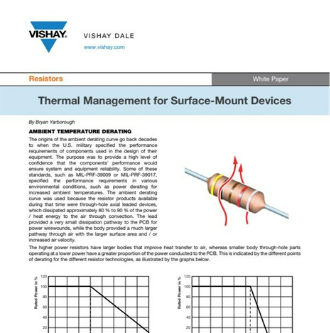Thermal Management for Surface-Mount Devices
The origins of the ambient derating curve go back decades to when the U.S. military specified the performance requirements of components used in the design of their equipment. The purpose was to provide a high level of confidence that the components' performance would ensure system and equipment reliability. Some of these standards, such as MIL-PRF-39009 or MIL-PRF-39017, specified the performance requirements in various environmental conditions, such as power derating for increased ambient temperatures. The ambient derating curve was used because the resistor products available during that time were through-hole axial leaded devices, which dissipated approximately 80 % to 90 % of the power / heat energy to the air through convection. The lead provided a very small dissipation pathway to the PCB for power wirewounds, while the body provided a much larger pathway through air with the larger surface area and / or increased air velocity.
The higher power resistors have larger bodies that improve heat transfer to air, whereas smaller body through-hole parts operating at a lower power have a greater proportion of the power conducted to the PCB. This is indicated by the different points of derating for the different resistor technologies, as illustrated by the graphs below.
Download this Whitepaper now for more information about thermal management for surface-mount devices.
Read More
By submitting this form you agree to Vishay Intertechnology contacting you with marketing-related emails or by telephone. You may unsubscribe at any time. Vishay Intertechnology web sites and communications are subject to their Privacy Notice.
By requesting this resource you agree to our terms of use. All data is protected by our Privacy Notice. If you have any further questions please email dataprotection@techpublishhub.com
Related Categories: Analog, Automotive, Components, PCB, Power, Resistors, Semiconductors


